|
|
Crossbow Pistol Plans Free
Free Plans for Building a Pistol Crossbow with Steel
Bow
How to Build a Pistol Crossbow
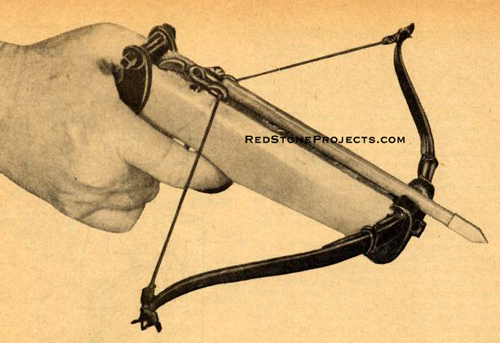

By Edwin Love
YOU'LL create quite a sensation at your next archery meet when you start
banging away at the target with bolts from your own hand-crafted pistol
crossbow. In fact, everyone will want to try his skill at shooting this
rare one-of-a kind weapon. This is no toy, either, and should be treated
with the same respect due any weapon. For the wallop this baby packs makes
it capable of driving a 6-in. bolt through a bull's-eye at 150 ft. Its
power is stored in a spring-steel bow which requires a special cocking
device ("goat's foot") to provide the leverage necessary to draw back the
bowstring and set it in the notched wheel of the weapon's trigger mechanism.
Your First Step in making the crossbow is to draw a 5 1/2 x 9-in.
grid of 1/2-inch squares on paper. Then copy the outline of the pistol
stock (side view, Fig. 3) using the 1/2-in. squares to enlarge it. Also
copy the outline of the cocking side plate and trigger guard. Use carbon
paper to transfer the pistol-stock drawing to 1 1/4-in-thick maple or walnut
stock. After sawing the stock to shape drill a 1/2-in. hole up through
the center of the pistol grip and then insert a 1/2-in. dowel, gluing it
in place. This will prevent the grip from splitting with the grain.
Make the Two Cocking Plates by first transferring your full-size drawing
of each to 1/8-in-thick steel. A series of prick-punch marks spaced about
1/8 in. apart along the outline will serve as a dotted guide line to follow
when cutting the steel. The latter is done by using a jigsaw or hand coping
saw fitted with a fine-tooth metal-cutting blade. (In a pinch you can rough-cut
these parts to size with a cold chisel, then file and grind them to the
correct dimensions.) Now clamp the two plates together and drill the holes
for the rivets, made from the shanks of 16d (3 1/2-in.) common nails. Countersink
these holes so that the rivets set flush.
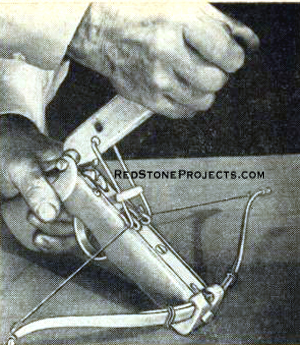
Figure 1. "Goat's Foot" cocks pistol crossbow -
hooks on channel sides, draws back bowstring,
sets it in wheel.
|
Next rough-file down each side of the stock grip to a thickness
of 1 1/8 in. Clamp the cocking plates to the sides of the grip so that
they are positioned as shown in Fig. 3 and drill rivet holes through the
grip. Then mark the grip for mortising the plates into it by tracing around
the plates with a sharp pencil. Remove the plates and cut around the mortise
edge with a gouge or narrow chisel making it slightly undersize. Make several
cut lines across the grain to break up chips and establish the 1/8-in.
depth of the mortise. Hollow out the mortise by hand chiseling or with
a router bit in a drill press. |
Replace the plates and hammer-tap them into the mortise edges so that an
imprint is left; after trimming to this imprint the plates will fit snugly.
Before replacing the plates, work the grip down to its rounded form with
chisel and rasp.
To aid in forming it symmetrically, make a couple of cardboard templates
(Fig. 3B) to check the roundness of the grip. Fair off the grip toward
the top and round the corners of the stock.
| Mortising for the Trigger Mechanism can be done now or after the plates
are riveted to the grip. In either case lay out the size of the mortise
on top of the stock and bore it out, starting with the end holes and working
toward the center with holes overlapping (Fig. 3C). Set the drill-press
depth gauge to avoid boring too deeply. Chisel the sides of the mortise
smooth and square the ends. |
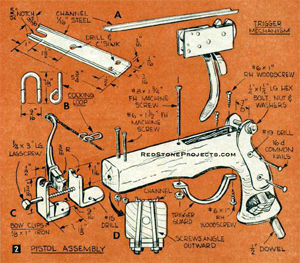 Figure 2. Crossbow Pistol Assembly
Figure 2. Crossbow Pistol Assembly
|
Before attaching the cocking plates grind them roughly to the contour of
the grip. Then force them into the mortises, push the nails through and
cut them to length for riveting.
By the way, the nails can be softened for easier riveting by heating
the ends red hot with a torch and allowing them to cool slowly. Now rest
the pistol grip on the vise anvil, nail heads down, and rivet the cut ends.
Turn the stock over then and hammer the nail heads into the countersunk
holes. Finish by filing the rivets flush with the plates.
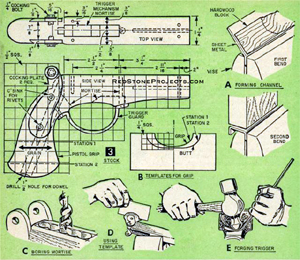
Figure 3. Pistol Crossbow Stock: 3A. Forming
Channel, 3B. Templates for Grip, 3C. Boring
Mortise, 3D. Using Template, 3E. Forging Trigger
|
The Trigger Mechanism Itself is started by first making the
notched wheel and detent, following the same procedure used when making
the cocking plates (note that these parts are shown full size in Fig. 5).
Forge the trigger from a 5/16-in. round steel rod by heating it red hot
and hammering it to shape. Flatten the upper part and shape the trigger
section with a ball peen hammer (Fig. 3E). Cut, clamp together and drill
the holes through both side plates. |
The plate drawing (Fig. 5) is full size so just paste it on the plate and
centerpunch the hole locations. Be sure to pair and countersink the plates
on the outsides so that the pivot post ends can be riveted flush on the
outside after assembly.
Make pivot posts from nails, shouldering them on a metal-turning lathe
(Fig 10). Lacking a lathe, you can do this work on a drill press by gripping
the nails in a chuck and filing the ends down to fit the plate holes. Use
a file having smooth or safe edges to make the shoulders square and sharp.
Here's How the Trigger Mechanism Works: The slot in the notched
wheel is held in position for accepting the bowstring loop by a small helical
spring beneath the wheel and anchored to the left plate with a screw (Fig.
9). The flat spring which holds down the detent is bent from a hair curler.
The detent locks the wheel against the pull of the cocked bowstring. The
lower end of the detent, pressing against the back of the trigger, holds
the trigger against its stop. When pulled, the trigger pushes back the
detent, the detent releases the wheel and the bow-string springs forward
and fires the bolt.
When assembling the trigger mechanism, first rivet the pivot posts to
one side plate.
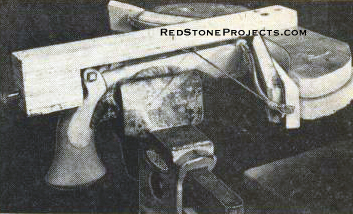
Figure 4. Turning the bolt in butt-end of this scrap
wood jig bends the bow until the free end of the
bowstring loop slips into its nock.
|
Then add washers, working parts and upper washers. Before riveting
the second side plate, test the action by pressing the wheel forward with
your fingers until it stops, checking to see if the wheel releases when
the trigger is pulled. |
The Spring-Steel Bow was made from the coiled spring of a hood hinge from
a 1953 Ford and was obtained from an auto wrecking yard. It is straightened
by gripping it in a vise (Fig. 6A), lifting the free end of the spring
and sliding a steel bar under it so that the latter rests on the vise jaws.
Now hammer the curved spring to flatten it on the bar. Then draw another
curved section over the bar for straightening. Straighten 15 in. of the
spring, then nick it on a grinder and break it to length.
| The unstrung bow should be bent somewhat in a reverse curve, as shown
in Fig. 6. Bend the ends by spanning them over vise jaws opened to 1 1/4
in. and hammering them with a ball peen. Grind a taper on the lower edge
of the bow toward the ends so that the bowstring will clear the channel.
Also grind the nocks (notches) at the ends of the bow to take the bowstring.
To strengthen the bow, straighten a 6-in. length of spring steel and taper
down the thickness toward the ends. Center this spring leaf behind the
bow and secure it with loops of bind wire. For an even stronger bow you
can put a 10-in.-long leaf between the main bow and the 6-in. leaf. |
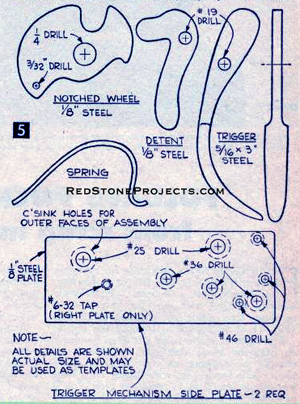 Figure 5. Crossbow Pistol Trigger Mechanism
Figure 5. Crossbow Pistol Trigger Mechanism
and Side Plates
|
Complete the bow by grinding the 3/8-in. notch - in the center of the upper
edges of the bow and leaves - which serves to clear the shot bolt.
The Spring-Steel Bow was made from the coiled spring of a hood
hinge from a 1953 Ford and was obtained from an auto wrecking yard. It
is straightened by gripping it in a vise (Fig. 6A), lifting the free end
of
the spring and sliding a steel bar under it so that the latter rests on
the vise jaws. Now hammer the curved spring to flatten it on the bar. Then
draw another curved section over the bar for straightening. Straighten
15 in. of the spring, then nick it on a grinder and break it to length.

Figures 6A. and 6B. Straightening the Spring and Binding the Bow
String Loop
The unstrung bow should be bent somewhat in a reverse curve, as shown
in Fig. 6. Bend the ends by spanning them over vise jaws opened to 1 1/4
in. and hammering them with a ball peen. Grind a taper on the lower edge
of the bow toward the ends so that the bowstring will clear the channel.
Also grind the nocks (notches) at the ends of the bow to take the bowstring.
To strengthen the bow, straighten a 6-in. length of spring steel and taper
down the thickness toward the ends. Center this spring leaf behind the
bow and secure it with loops of bind wire. For an even stronger bow you
can put a 10-in.-long leaf between the main bow and the 6-in. leaf. Complete
the bow by grinding the 3/8-in. notch - in the center of the upper edges
of the bow and leaves - which serves to clear the shot bolt.
The bow is held in place with clips bent from 1/8 x 1-in. steel (Fig.
2C). A lag screw passing through the clips into the end of the stock locks
the bow between the clips. Two machine screws passing through the forward
end of the stock, and at an outward angle toward the bottom so as to clear
the lag screw, fasten the Pistol Crossbow clips and channel to the stock.
To Make the Channel detailed in Fig. 2A, bend 1/16-in. sheet
metal as shown in Fig. 3A, then trim and file the upper edges. Cut the
notch at the rear of the channel with a file and drill the holes for the
screws. The center screw also serves to fasten the forward end of the trigger
guard, while a couple of round head wood screws near the back bear against
the sides of the channel, their heads bearing on the top edges.
Make the trigger guard from 1/8 x 3/8-in. steel or aluminum bar stock,
bending it as indicated in the drawing of the gun stock.
In assembling the pistol, place the trigger mechanism into its mortise,
set the channel on top of the stock, insert the screws, then add the bow,
clips and trigger guard as shown in Fig. 2.
Make the bowstring (Fig. 6B) by bending one end into a loop just large
enough to slip over the end of the bow. Holding the loop in a vise, wrap
half the length of the short cable with spooled binding wire. Then fray
out the cable end, bend the strands back over the binding and wrap these
also with wire.
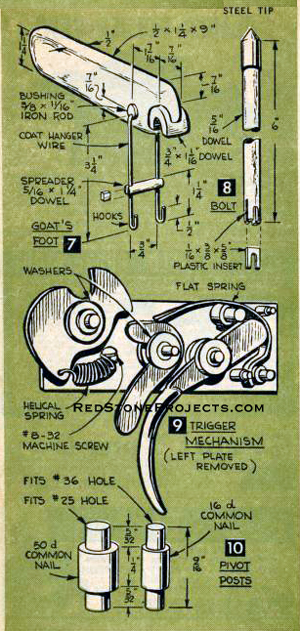 Figure 7. "Goat's Foot", Fig. 8. Bolt, Fig. 9. Trigger
Figure 7. "Goat's Foot", Fig. 8. Bolt, Fig. 9. Trigger
Mechanism, Fig. 10. Pivot Post
|
Make the Cocking Loop (Fig. 2B) from coat-hanger wire and slip
it in the bowstring before binding the other loop. To "brace" or string
the bow, make a jig from scrap wood as in Fig. 4. The bolt on the end of
the jig presses against a piece of metal set between the cocking plates.
As the bolt is tightened the forward end of the jig Is pulled against the
bow, bending it. Further bending can be achieved by driving wedges between
the jig and bow. Slip the bowstring loops over the bow ends, and to keep
them from slipping out of the bow nocks wrap binding wire behind the nooks,
around to the front and then back over the bowstring loops. Twist the wire
ends tightly and cut them off short.
The Goat's Foot or cocking handle (Fig. 7) is shaped from hardwood
and fitted with a half cylinder made from a hardwood dowel which bears
on the cocking bolt. The hooks are bent from coat-hanger wire passed through
an off-center hole in an iron bushing. |
A spreader made from a dowel is fashioned to make a sliding fit between
the hooks and the outer edges of the channel. The goat's foot cocks the
crossbow by drawing the bowstring back and setting it in the wheel notch
which is attached to the trigger mechanism. Once the crossbow is cocked
the goat's foot is removed. For easy carrying, the goat's foot can be fitted
with a hook and you can hang it from your belt.
Finish the wooden parts of the pistol and the goat's foot with three
coats of floor sealer. Polish the metal parts and blue them with bluing
compound obtainable at gun shops.
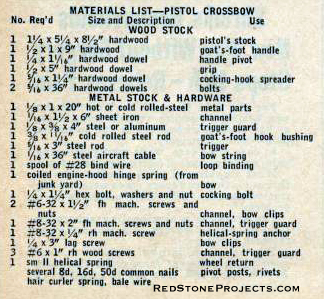
Crossbow Pistol Materials List
Number Required, Size and Description, and Use
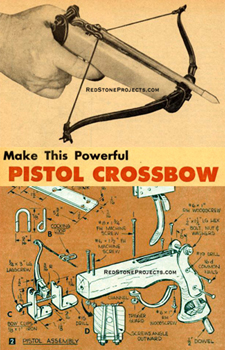
Get a restored, printable copy of these Pistol Crossbow
Plans with
Enhanced and Enlarged Figures and Illustrations and Searchable
Text.
|
|
Make This Powerful Pistol Crossbow
|

|
PDF Format
|
All Orders Processed
On a Secure Server
|
|
|
|
Price $12.95
|
|
|
|
We will email your plans, to the address provided
with your payment, within 48 hours following receipt of your order.
|
10 Pages
Print Size 8.5" x 11"
|
|
|
Save up to 50% with Multi-Plan Deals
|
| 2 Plans $19.95 FREE Shipping
- Save Over 30%U.S. Orders Only |
|
Crossbow Pistol Plans Free - Free Plans for Building a
Pistol Crossbow with Steel Bow |